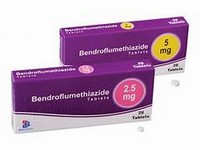Bendroflumethiazide
CLINICAL USE
Thiazide diuretic:
DOSE IN NORMAL RENAL FUNCTION
Oedema: 5–10 mg in the morning or alternate days
PHARMACOKINETICS
DOSE IN RENAL IMPAIRMENT
GFR (mL/MIN)
DOSE IN PATIENTS UNDERGOING RENAL REPLACEMENT THERAPIES
IMPORTANT DRUG INTERACTIONS
Potentially hazardous interactions with other drugs
ADMINISTRATION
Reconstition
–
Route
Oral
Rate of Administration
–
Comments
–
OTHER INFORMATION
Monitor for hypokalaemia Thiazide diuretics are unlikely to be of use once GFR<30 mL/min
